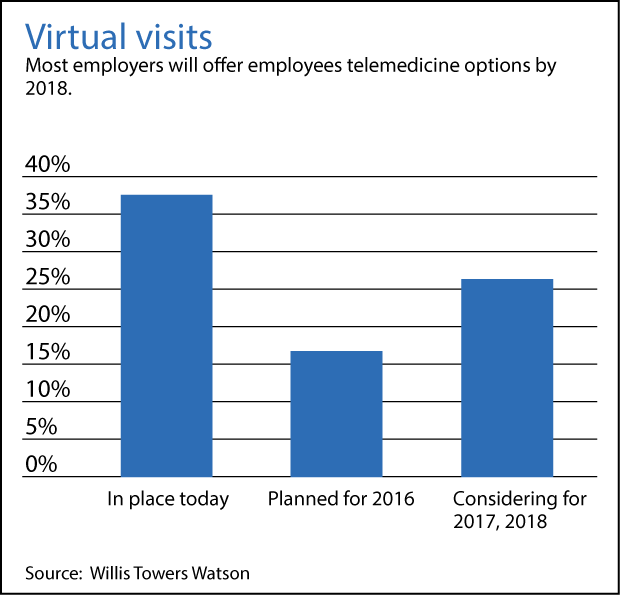The idea to assess human health from afar started with NASA in the early 1960s. Both American and Russian doctors were concerned that astronauts might lose circulation and other functions in space. The first telemedicine was practiced on animals attached to medical monitors while orbiting Earth.
TV viewers became familiar with live updates on astronauts’ heart rates, breathing and temperature during space flights. And the technology has translated right into employer benefit plans for medical care for onsite and offsite workers.
Over 15 million Americans obtained medical care remotely in 2015,[i] and the American Telemedicine Association anticipates 30% growth in 2016. Employers have picked up on the cost savings and convenience—nearly 75% of large employers plan to offer telemedicine as a health plan benefit in states that regulate this method, up from 48% in 2015.[ii]

Why Telemedicine?
Employers are searching for ways to contain the spiraling costs of health care. The ability for employees to make a call or have a video conference with a board-certified doctor within minutes brings both convenience and less time away from work. A recent analysis by Willis Towers Watch estimated that as much as $6 billion per year could be saved by U. S. companies using telemedicine.[iii]
Where the Savings Come From
Employers are seeing the need to educate employees about the best medical options for every health need. Some fevers, headaches, sore throats and other minor symptoms are appropriate for a telemed call (see “Treatment Alternatives to the Emergency Room”). Average cost: $45.
Compare the cost of a telemed call with an average primary care doctor visit: $145. Or the average cost of an ER visit: $1,316. [iv] Your employees with commutes to work may have to travel longer distances for in-person visits—time also lost in productivity. And many employees allow conditions to worsen before seeking treatment, resulting in even higher expense and time away from work.
“Over 400 million visits a year are appropriate for telehealth.”
– Jason Gorevic, Teladoc CEO, NJTV News
Managing Costs in a Complex Environment
As responsibility for paying health bills shifts to the employee, 24/7 services such as Teladoc Health become an increasingly attractive option for appropriate levels of medical care. A board-certified doctor is always available with a cell phone callback, even if an employee is on vacation or lives in a rural area where medical access is more limited.
MedCost clients who use Teladoc have already saved hundreds of thousands of dollars in 2016, avoiding more expensive treatment centers and lost hours at work.
Looming in employers’ minds is the Affordable Care Act’s Cadillac tax, now postponed until 2020. This 40% excise tax would trigger when an employer offers health benefits above $10,200 for an individual and $27,500 for a family.
Employers have already begun to raise employee deductibles and out-of-pocket costs, not included in the value of a health policy.

Summary
Some large employers such as JetBlue Airways are installing telemed kiosks at their workplaces, harnessing technology innovations for immediate care.[v] The Department of Veteran Affairs provided telemed services to more than 675,000 veterans in fiscal 2015. Employees who are used to searching for restaurants and shopping deals on cell phones will increasingly call a doctor to get routine medical care.
And it won’t even require a trip to outer space to get it.
[i] Melinda Beck, “How Telemedicine Is Transforming Health Care, Wall Street Journal, June 27, 2016, http://www.wsj.com/articles/how-telemedicine-is-transforming-health-care-1466993402 (accessed July 14, 2016)
[ii] National Business Group on Health, “Health Care Benefits Cost Increases to Hold Steady in 2016,” August 12, 2015,https://www.businessgrouphealth.org/pressroom/pressRelease.cfm?ID=263 (accessed July 18, 2016)
[iii] Willis Towers Watson, “Current Telemedicine Technology Could Mean Big Savings,” August 11, 2014, https://www.towerswatson.com/en-US/Press/2014/08/current-telemedicine-technology-could-mean-big-savings (accessed July 15, 2016)
[iv] Sabrina Rodak, “Study: 71% of ED Visits Unnecessary, Avoidable,” Becker’s Hospital Review, April 25, 2013, http://www.beckershospitalreview.com/capacity-management/study-71-of-ed-visits-unnecessary-avoidable.html (accessed February 23, 2016)
[v] Phil Galewitz, “Kaiser: Your Doctor Will See You Now,” June 20, 2016, http://www.usatoday.com/story/news/2016/06/18/kaiser-how-far-telemedicine-has-come/86084092/ (accessed July 18, 2016)





Add new comment